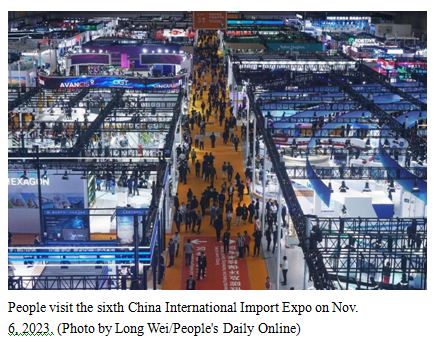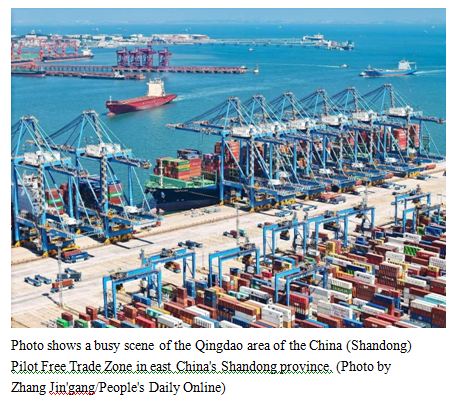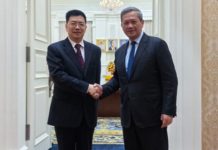By Yu Yichun, Cao Shiyun, People’s Daily
This year marks the 30th anniversary of the first Asia-Pacific Economic Cooperation (APEC) Economic Leaders’ Meeting. Over the past 30 years, China’s deepening reforms and expanding opening up have gone hand in hand with the continuous expansion of Asia-Pacific economic cooperation.
Since 2013, Chinese President Xi Jinping has attended or chaired APEC Economic Leaders’ Meetings and delivered important speeches.
From “building an Asia-Pacific community with a shared future” to “creating and fulfilling an Asia-Pacific dream,” and from “forging an Asia-Pacific partnership” to “building a high-quality Asia-Pacific connectivity network,” Chinese ideas and proposals have sparked strong resonance in the Asia-Pacific region, making significant contributions to the stability and prosperity of the region.
China’s opening up and development are closely related to the Asia-Pacific region. China has always been a staunch supporter and active promoter of Asia-Pacific regional economic cooperation, integrating its own development with regional development and driving the opening up of the whole region through its own opening up.
In 2022, China’s trade volume with Asia-Pacific economies reached $3.1 trillion, a year-on-year increase of 19.2 percent, accounting for 36.8 percent of China’s total foreign trade.
During the same period, China’s high-quality implementation of the Regional Comprehensive Economic Partnership (RCEP) resulted in a total of 12.95 trillion yuan ($1.78 trillion) in imports and exports to other RCEP members, growing 7.5 percent from a year ago.
According to the Asian Economic Integration Report 2023 by the Asian Development Bank, Asia’s economic recovery is driven particularly by China, which accounted for 64.2 percent of total growth.
China has been making continuous and concrete efforts to deepen trade and investment cooperation with regional economies, contributing its part to building an open economy in the Asia-Pacific.
It pushed for the launch of the process to build a Free Trade Area of the Asia-Pacific at the 2014 APEC meeting in Beijing, and actively worked to join the Comprehensive and Progressive Agreement for Trans-Pacific Partnership and the Digital Economy Partnership Agreement. Furthermore, China has been actively promoting the China-ASEAN Free Trade Area 3.0 with ASEAN members.
The 30th APEC Economic Leaders’ Meeting, with the theme of “Creating a Resilient and Sustainable Future for All,” conveys the significance of green development and innovation for the Asia-Pacific region.
Under the active promotion by the Chinese government and the vigorous participation of Chinese enterprises, cooperation platforms such as the APEC Sustainable Energy Center and the China-Pacific Island Countries Climate Change Cooperation Center have gradually been established. Green development projects, including the Dzilam State Reserve located in Mexico’s Yucatan Peninsula, have commenced, contributing Chinese wisdom and solutions to building a clean and beautiful Asia-Pacific region.
APEC Secretariat Executive Director Rebecca Sta Maria noted that China has demonstrated its determination to achieve sustainable development through practical actions and has fulfilled its international commitments in the field of sustainable development.
Leveraging the digital twin technology, Chinese scientists are providing more solutions for the protection of marine biodiversity in Latin American countries. By introducing technologies such as 5G, cloud computing, and artificial intelligence, Chinese companies are helping Thai hospitals achieve comprehensive intelligent transformation in their services. With the assistance of the China-ASEAN Information Harbor, the level of cross-border trade and economic services between China and ASEAN countries continues to improve.
China not only leads the world in technological innovation and digital economic development, but also actively promotes digital transformation in the Asia-Pacific region and even the world at large.
Working with its partners to promote high-quality Belt and Road cooperation, China is improving the connectivity level in the Asia-Pacific region. It proposed to establish the Asian Infrastructure Investment Bank, aiming to provide financial support for regional infrastructure development.
China has hosted a series of international exhibitions such as the China Import and Export Fair, China International Fair for Trade in Services, and the China International Consumer Products Expo at high standards, collaborating with various parties to write stories of open cooperation and mutual benefit.
The just-concluded sixth China International Import Expo achieved fruitful results, with tentative deals reaching a new high of $78.41 billion, a 6.7 percent increase from the previous year.
China is committed to advancing high-level opening up, continuously providing new opportunities for the Asia-Pacific region and the world through its new development, and contributing Chinese strength to the construction of an open world economy.
Major countries should shoulder great responsibility. The United States is the host of the 30th APEC Economic Leaders’ Meeting. China and the United States are the world’s top two economies, accounting for over 1/3 of the global economic output, nearly 1/4 of the world’s population, and approximately 1/5 of global bilateral trade. They play a unique and important role in driving economic growth in the Asia-Pacific region and promoting regional cooperation.
The wide globe is fully capable for the two countries to develop themselves and prosper together. Stabilizing and improving China-U.S. relations not only serves the fundamental interests of both countries and their peoples, but also contributes to peace and prosperity in the Asia-Pacific region and even the world.
The world is once again at the crossroads of history. Under the new situation, Asia-Pacific economies need to learn from past experiences and lessons, respond to the challenges of the times and steadfastly advance Asia-Pacific regional economic integration, so as to jointly break new ground in development and build an Asia-Pacific community with a shared future. They will contribute wisdom and strength to world peace and development with the stability and prosperity of the Asia-Pacific region.


















